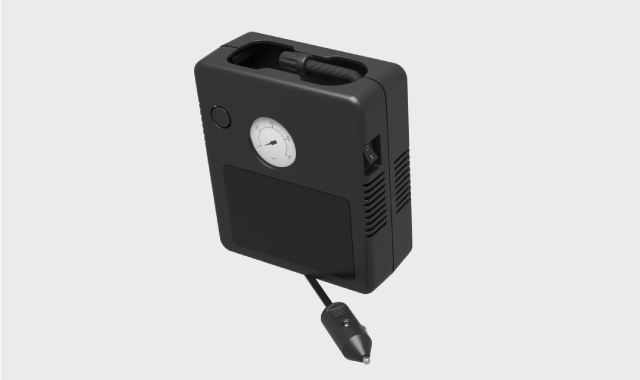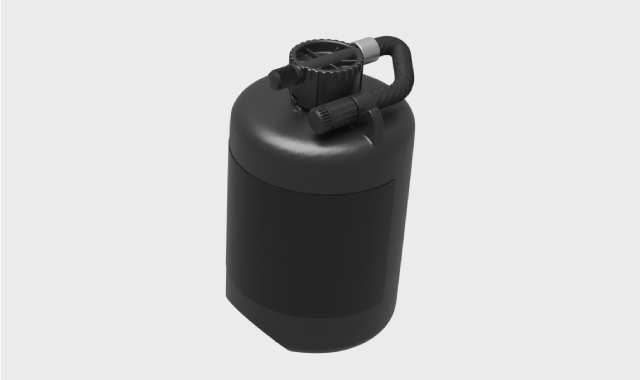Note
These instructions apply to the temporary puncture repair kit supplied by Volvo.

4
1
3
2
5
- 1Pressure-reducing valve
- 2Pressure gauge
- 3Air hose
- 4Power switch
- 5Electrical cable

1
2
- 1Sealing fluid hose
- 2Air hose connector
Warning
Sealing fluid can be harmful
The sealing fluid contains substances that are harmful if swallowed. The contents can also cause allergic reactions or be otherwise harmful to the respiratory tract, the skin, the central nervous system and the eyes.
Precautions
- Store the kit out of reach of children.
- Avoid prolonged or repeated contact with the skin. If you get sealing fluid on your clothes, remove them.
- Wash hands thoroughly after handling.
First aid
- Ingestion: Do not induce vomiting unless directed to do so by medical personnel. Get medical attention.
- Skin: Wash affected areas of skin with soap and water. Get medical attention if symptoms occur.
- Eyes: Flush with plenty of water for least 15 minutes, occasionally lifting the upper and lower eyelids. Get medical attention if symptoms occur.
- Inhalation: Move the exposed person to fresh air. If irritation persists, get medical attention.
- Make sure the compressor's power button is in the off position before starting.
- Don't remove the air hose or sealing fluid hose during repair.
- If the puncture was caused by a nail or similar and it's still in the tyre, leave it in. This helps to seal the puncture.
- If the repair is carried out in an area where there might be other vehicles, activate the hazard warning lights and use a warning triangle, if you have one.
Preparations

Screw the air hose to the sealing fluid bottle. There's a place for it opposite to the sealing fluid hose.
Unscrew the tyre valve's dust cap and attach the sealing fluid hose. Screw the hose connector as far down the thread as possible.
Begin puncture repairs
Connect the compressor to the car's 12 V socket and ensure that the socket works and is supplying current.1
Start the compressor by pressing the power button.
Warning
Never stand next to the tyre while the compressor is on. If cracks or bumps appear, the compressor must be turned off immediately. Stop and contact Volvo Assistance for safe recovery.
Note
Avoid placing the compressor in water, directly on sand or on very dusty ground as this may cause the compressor to malfunction.
Inflate the tyre until the pressure is greater than 1.8 bar (26 psi).
Shut the compressor off to check the pressure on the pressure gauge. Minimum pressure is 1.8 bar (26 psi) and maximum is 2.8 bar (39 psi). Use the pressure-reducing valve if the pressure is too high.
Warning
If the pressure is below 1.8 bar (26 psi), the hole in the tyre is too big. Do not continue and contact Volvo Assistance for safe recovery.
Unplug the compressor from the 12 V socket.
Unscrew the sealing fluid hose from the tyre.
Refit the tyre valve's dust cap.
As soon as possible, drive for 10 minutes2 at a maximum speed of 60 km/h (37 mph) and let the fluid seal the tyre. After that, perform a follow-up check.
Follow-up check
Connect the air hose to the tyre's air valve.
Check the tyre pressure on the compressor's pressure gauge.
- If the pressure is below 1.3 bar (19 psi), the tyre is insufficiently sealed. Stop and contact Volvo Assistance for safe recovery.
- If the pressure is higher than 1.3 bar (19 psi) but below 1.8 bar (26 psi), the tyre must be inflated to a minimum pressure of 1.8 bar (26 psi) and a maximum pressure of 2.8 bar (39 psi). Connect the compressor to the 12 V socket and inflate the tyre. Release air using the pressure-reducing valve if the tyre pressure is too high. Then redo step 10.
- If the pressure is between 1.8 bar (26 psi) and 2.8 bar (39 psi), you can drive at a maximum speed of 80 km/h (50 mph).
Refit the tyre valve's dust cap.
- Replace the sealing fluid bottle and hose after use. Contact a Volvo dealer to do so.
- Volvo recommends replacing or repairing the damaged tyre as soon as possible. Inform the workshop that the tyre contains sealing fluid.
Warning
Maximum mileage with tyres containing sealing fluid is 200 km (125 miles).